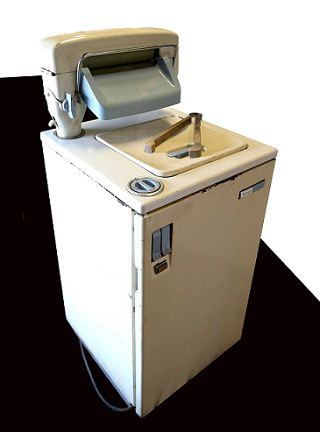

The wringer on top of this washing machine makes it look laborious to use, but in the 1950s the manufacturers, Servis, advertised it with slogans like ‘a wringer so easy, a child can wring a blanket’. The placing of the upright tub inside a sleek, white cabinet was, at the time, the height of domestic modernity. In an Irish country kitchen, this British-made appliance was an object from a brave new world.
In a roundtable discussion on Irish feminism in 2010, journalist Geraldine Kennedy asked a group of women ‘What invention changed any of your lives most?’ Mamo McDonald, born in 1929 and long a leading figure in the Irish Countrywomen’s Association, replied without hesitation ‘the washing machine’. Washing machines had been available to wealthy households in Ireland since the mid-nineteenth century. By the 1940s electric machines were reasonably common in the more prosperous parts of urban Ireland, though still described as ‘luxuries’. The really large-scale social impact of the washing machine had to await not just the availability of cheaper automatic machines after the Second World War, but general access to both piped water and electricity in Ireland’s still largely rural society.
McDonald recalled that the ICA ‘carried out a campaign for water in the home and urged rural women not to marry a farmer unless he installed water in his house as well as his byre…“why would you be bothered putting it into the kitchen, wasn’t she well fit to carry a few buckets”, [was the] sort of attitude’. The other necessity for washing machines in the home was electricity. In 1925 there were 161 separate local electricity systems in Ireland; these were subsumed into the new state-owned Electricity Supply Board in 1927. The success of the ESB, embodied in the pioneering hydro-electric scheme at Ardnacrusha on the Shannon river, led to the connection of 240,000 consumers by 1945. The huge post-war electrification scheme to connect to the system the 400,000 rural homes still without power was one of the great achievements of independent Ireland.
Peter Sheridan, in his memoir 44: Dublin made me, recalled the arrival of the washing machine in his working-class home: ‘It’s a dream machine…the housewife’s friend and more reliable than a husband’. The machine liberated women from the time-consuming, back-breaking drudgery of washing clothes (and nappies) by hand.
Organised feminism, from the early 1970s, challenged the idea that a woman’s role was confined to the home. In the long term, the contraceptive pill, though only fully legalised in Ireland in 1993, may have had a more revolutionary effect, but the easing of the domestic burden wrought by the arrival of the washing machine was an important prelude to more high-profile changes in the status of women: the lifting (in 1973) of the ‘marriage bar’ that forced women to leave public service jobs when they married; the right to sit on juries (1976); the right to a share in the family home (1976) and equal pay (1974). There was, by the end of the 1970s, even the hope that washing machines might also be of interest to men.